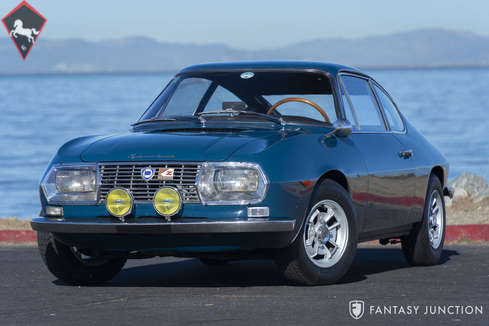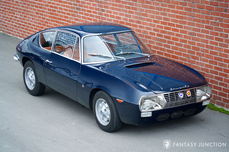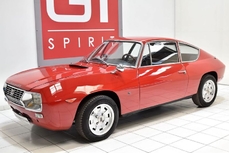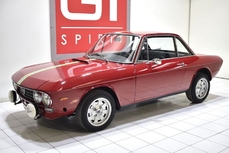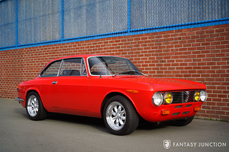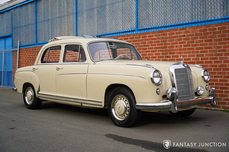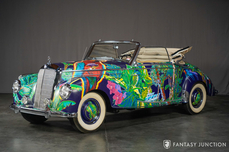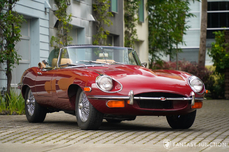Lancia Fulvia 1300cc Inline Four 1966
General description :
1966 Lancia Fulvia Sport Zagato
Chassis Number – 818.132.001155
Engine Number – 818.302*017859*
Exterior Color –Blue Mendoza
Interior Color - Red
Engine Type – 1.3L V4 OHC
Gearbox – 4-speed manual
Current Miles – 100,507 miles TMU
Features of This Example
Final example of just 202 alloy bodied 1.2L Sport Zagato Lancias built
Tastefully upgraded to 1.3L engine (early 1968 series V4 engine)
Ordered brand new by Oscar-nominated film editor Hugh Lloyd
Correct plexiglas headlight cover car as new from the factory
General History
An italian sports car with Zagato coachwork, disc brakes, and twin cam engine, the Fulvia Zagato put the finishing touch on an era of superlative coachbuilt sports cars. Long regarded for their exceptional craftsmanship, innovative engineering, and cost-no-object attention to detail, prior to Fiat involvement, Lancia built elegant and refined performance cars with few rivals.
Among the last of the pre-FIAT cars, the unibody front-drive Fulvia was designed with a dual overhead cam narrow angle common cylinder head V4 engine. Dunlop disc brakes on all four corners provided stopping power, along with a host of further technical features. In 1967, Road and Track magazine described the car as "a precision motorcar, an engineering tour de force". The Fulvia was surprisingly quick for its displacement and proved to be formidable in both rally and circuit racing. The rare and special Zagato coupe bodywork, available in limited quantities, provided excellent visibility and a surprising amount of space for larger drivers. The first of the Zagato series cars were hand formed with all alloy construction with 1.2L engines. This lightweight combination and handmade quality make these earliest examples the most sought after today.
Owner History
With an unbroken chain of known ownership beginning with the original owner, Oscar nominated film editor Hugh Lloyd, this Sport Zagato was manufactured in 1966 and first registered to Llyod on plate TI3132 January 16, 1967, a resident of Turin, Italy. Per his order, the car was outfitted with UK instrumentation, and later Lloyd had Dinitrol rustproofing applied to the chassis, fitting a set of 5 FPS alloy wheels, which are still on the car today. A car enthusiast, Llyod was a member of the Automobile Club D’Italia, announced by the Roma division windows sticker still on the car today.
On February 3, 1970 Llyod imported the car to the UK, registering it on export plates EE43470, later registering it on EPE199J. In 1983 Llyod sold the car to Goodwood racer Chris Gawne who updated the engine to the more desirable 1.3L variant outfitted with Dellorto carburetors. The car changed hands a few times before it came into the collection of BaT enthusiast Alex_V who offered it for sale on BaT in February 2015 https://bringatrailer.com/list... At that time, the car showed 99,000 miles, the majority of which were accrued under Lloyd’s ownership.
Ownership history includes:
Hugh Lloyd – 1966-1983
Chris Gawne – 1983-1999
Roger Mills – 1999-2002
N. Linguard – 2002-2005
Richard Thorne – 2005-2007
Jaqueline Gawne – 2007-2013 (wife of second owner)
Clive Winstone – 2013-2014 (classic car dealer)
Alex Vazaios – 2014- 2015
Cosmetic Overview
Today, this Sport Zagato presents in very attractive condition with glossy paint applied over handsomely finished aluminum body work. The chrome and various trim are all in very good condition, particularly the exceptionally hard to find grille and chrome plated headlight bezels along with the rare plastic headlight covers. A pair of bumper mounted Carello driving lamps are also in place, likely period mounted, as earlier photos show the car with chrome caps over the bolt holes. The lenses, glass, and delicate “Fulvia Sport” script across the hood announce both the Italian heritage and design excellence, while Zagato coachwork badges confidently flank both front fenders. The desirable later series cast alloy wheels were added in period and today are in excellent shape, adding a sporting period-correct enhancement to the car, giving it great stance. Many of these cars often sit a bit high in the rear, however the stance in this example is visually satisfying, giving the car just the right amount of forward rake.
The color-contrasting interior is excellent overall, reupholstered in correct red with appropriate headliner and rear carpet treatment done in high quality materials. The low-profile bucket seats are in excellent condition with comfortable bolsters and good side support. The door panels and headliner are in very nice condition. The wood dash trim is properly finished, housing the correct instrumentation, clock, and rare radio delete plate with Fulvia script. The gauges and controls feature nice color and contrast, excellent trim, and a correct Lancia badged wood rim steering wheel. The correct ribbed and fitted rubber floor mats are similarly nice as is the rubber booted shifter. Lifting the rear hatch, the storage space area is nicely finished and properly trimmed with space for soft weekend luggage. Additionally, the rear hatch can be electronically raised and lowered via a dash switch, allowing cabin ventilation – among one of the more notable innovations of this model. The spare tire is accessed via a drop-down rear fascia body panel and contains a matching alloy wheel, spare tire hold down, jack and partial tools.
The engine compartment is accessed via early series side hinged hood tilting open to display the angled V4 engine. Both the engine and engine compartment are very nicely prepared, with proper finishes, original components, and properly sorted hardware. The engine is a correct type 303 1.3 L series engine, outfitted with desirable Dellorto carburetors. The engine compartment is correctly finished with original colors and textures including the Lancia black crinkle paint on the twin cam head, original air cleaner housing, proper hoses, and correct green spark plug wires.
The car runs and drives well, starting easily, revving freely, and shifting smoothly. The disc brakes are very effective for this period and the chassis has a nice coherent and comfortable feel that is perfectly suited for mountain roads and spirited driving. The Fulvia is known for light and communicative steering, delivering precise and responsive results – certainly one of the top characteristics of this model.
This is an excellent opportunity to acquire a rare, technically interesting, and entertaining classic Lancia Sport Fulvia with unique all alloy hand formed Zagato coachwork. Extraordinarily rare in the United States, Fulvias have robust US based parts and service availability and can be easily serviced by mechanically minded enthusiasts, making them ideal usable vintage sports cars with unique construction, satisfying performance, and exceptional design traits.
Included with this car
Extensive original documentation supporting the original owner purchase, import documentation, automobile club card, UK ownership from first owner, FIVA identity card, interior restoration invoice, older service invoices, a matching alloy spare tire, spare tire hold down, jack, and partial tools accompany the car.
Walkaround video: https://youtu.be/1oYOxz97fY0Driving video: https://youtu.be/KcFu87PnWVc
https://fantasyjunction.com/inventory/1966-lancia-fulvia-sport-zagato/overview
1966 Lancia Fulvia 1300cc Inline Four is listed sold on ClassicDigest in Emeryville by Fantasy Junction for Not priced.
Car Facts
Car type : Car Make : Lancia Model : Fulvia Model Version : 1300cc Inline Four Engine size : 1.3 Model Year : 1966 Location : Emeryville Vehicle Registration : Normal
Sold
Seller Information
Sold
People who viewed this Lancia Fulvia also viewed similar Lancia listed at ClassicDigest
Other cars listed for sale by this dealer
About Lancia
Ah, Lancia, the Italian marque that danced on the edge of automotive brilliance! Let me take you on a journey through the captivating story of Lancia, a brand that embodies passion, innovation, and rallying prowess.Act 1: The Early Years (1906-1920s)
Lancia was founded in 1906 by Vincenzo Lancia, an engineering wizard with a flair for the extraordinary. The brand quickly gained a reputation for its precision engineering and innovative approach. The Lancia Alpha, introduced in 1907, was the first car to feature a narrow-angle V4 engine, setting the tone for Lancia's commitment to technical excellence.
Act 2: Innovation at its Core (1930s-1950s)
The 1930s saw Lancia pushing the boundaries of innovation with models like the Lambda, the first car to feature a load-bearing monocoque chassis. The Aprilia, introduced in the 1930s, showcased cutting-edge aerodynamics and a V4 engine, solidifying Lancia's reputation as a pioneer.
Act 3: Post-War Elegance (1950s-1960s)
After World War II, Lancia continued to dazzle with models like the Aurelia, the first production car to feature a V6 engine. It blended performance with comfort and elegance. The Flaminia followed, embodying luxury and advanced engineering.
Act 4: Rally Domination (1970s-1980s)
Lancia etched its name in motorsport history with an unparalleled rally legacy. The Lancia Stratos, a wedge-shaped wonder, dominated the rally scene in the 1970s, clinching three consecutive World Rally Championships from 1974 to 1976. The Delta Integrale, introduced in the 1980s, continued this rally reign with multiple championships.
Act 5: Struggles and Resilience (1990s-2000s)
The latter part of the 20th century brought financial challenges for Lancia, leading to collaborations with other automakers. Despite the difficulties, Lancia introduced models like the Thesis and the Ypsilon, showcasing its commitment to style and substance.
Act 6: 21st Century Reinvention (2010s-Present)
In the 2010s, Lancia faced a shift in strategy, focusing on the Ypsilon as its primary model. While production numbers dwindled, the brand maintained its reputation for distinctive design and comfort.
Epilogue: A Legacy of Passion and Innovation
Lancia's story is one of passion, innovation, and motorsport glory. The brand, with its groundbreaking designs, technological advancements, and rallying triumphs, has left an indelible mark on the automotive world. Lancia may have faced challenges in recent years, but its legacy lives on, celebrated by enthusiasts who recognize the magic woven into each Lancia creation. Finally, Here are some of the most important Lancia models that have left an enduring mark:
1. Lancia Lambda (1922-1931):
The Lancia Lambda is often considered a pioneering model, being the first car to feature a load-bearing monocoque chassis. This innovation set the stage for modern automotive design. The Lambda was available in various body styles and showcased Lancia's commitment to engineering excellence.
2. Lancia Aurelia (1950-1958):
The Aurelia, introduced in the early 1950s, was a groundbreaking model for Lancia. It was the first production car to feature a V6 engine, and it incorporated advanced engineering, including a rear transaxle and inboard rear brakes. The Aurelia set new standards for performance and comfort.
3. Lancia Flaminia (1957-1970):
Continuing Lancia's tradition of combining style with innovation, the Flaminia was introduced as a luxury sedan. It featured a V6 engine, a de Dion rear suspension, and avant-garde styling. The Flaminia further solidified Lancia's reputation for producing high-end, technically advanced vehicles.
4. Lancia Stratos (1973-1978):
The Lancia Stratos is an icon in the world of rallying. Born out of Lancia's rallying ambitions, the Stratos was purpose-built for competition. With its distinctive wedge-shaped design and a mid-mounted V6 engine, it became the first car to win the World Rally Championship three times consecutively from 1974 to 1976.
5. Lancia Delta (1979-1994):
The Lancia Delta is synonymous with rally success. It dominated the rally scene in the late '80s and early '90s, winning six consecutive manufacturers' titles in the World Rally Championship. The Delta's combination of performance, agility, and versatility made it an icon both on and off the rally stages.
6. Lancia Thema 8.32 (1986-1994):
The Lancia Thema 8.32 was a performance-oriented version of the Thema sedan, and it stood out for its collaboration with Ferrari. It featured a 3.0-liter V8 engine sourced from Ferrari, making it one of the few sedans with a Ferrari powerplant. This model showcased Lancia's ability to blend luxury and performance.
